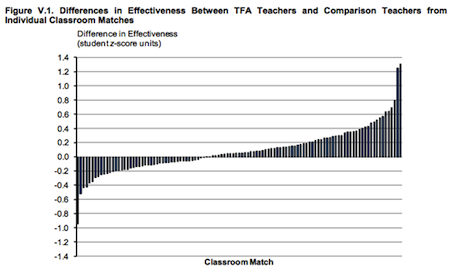If you want a summary of the new study on Teach For America (TFA) and TNTP’s Teaching Fellows program, see Stephen Sawchuk for the short-ish version or Dylan Matthews for the longer version (with charts!). If you want some additional background and context, read . I’m not going to cover the study in too much detail except to point out a few things that are getting lost:
1. Neither TFA nor Teaching Fellows are doing harm to our nation’s schools or our low-income students. In fact, TFA seems to be out-performing not just other beginning teachers but veteran teachers as well. The average “TFA” teacher in the study had 1.9 years of experience, but they were compared to teachers with an average of 10.1 years of experience. TFA teachers still did better. (Teaching Fellows in the study had four years of experience and they were no worse than their comparison group of teachers who had 13 years of experience.)
2. Yes, experience matters, but the TFA “effect” is even larger. Some, like Dana Goldstein and Diane Ravitch have called the TFA effects “small.” On average across middle and high school math, TFA teachers out-performed veteran teachers by 0.07 standard deviations, the equivalent of 2.6 additional months of instruction or helping a student move from the 27th to the 30th percentile on a normal distribution of test scores. If these seem small to you, keep in mind that these “small” TFA effects were 14 times larger (!) than the value of an additional year of experience and that things like teachers’ college selectivity, whether they had a math major, or their prior coursework in math had no effect at all.
3. Rotherham mentions in his post that, while averages are important, even TFA has wide discrepancies between its best and worst teachers. To see what this looks like in practice, check out the graph below. The lines represent the distance between a TFA teacher and their “matched” comparison teacher. The higher the upward line, the better their students performed. Notice that there are more upward lines than downward ones. This is reflected in the averages, but notice that there are downward ones. TFA produces some bad teachers, too. But, who are those teachers at the far right? We should find them, figure out what they’re doing, and try to learn from them. TFA does this internally but teacher preparation programs and schools across the country should be looking to identify those people too.

Finally, there’s another important report on teachers out this week from NCES that isn’t getting as much coverage as the TFA/TNTP report but is worth a look. It followed the career trajectories of a nationwide sample of teachers who began teaching in 2007-08. The study tracks the teachers over four years and provides an updated look at how many teachers stayed in the profession, changed schools, or moved districts. Here are the topline findings:
• Just over half of the teachers in the sample (50.3 percent) taught in the same school all four years. Another 8.5 percent taught in the same district all four years, and 14.1 percent taught all four years but not all in the same district. To put these numbers in a national context, the authors estimate there were 156,100 beginning teachers in 2007-08. Of those, 83,300 stayed in the same school, another 16,100 stayed in the same district, and another 18,900 stayed teaching all four years.
• Retention rates didn’t vary among different groups as much as you might expect. For example, there were few differences by age (over or under 30), highest degree attained, the length of time a teacher had student- taught, the number of teaching methods courses taken, grade level taught, community type, and whether a teacher had ongoing guidance from a mentor. Even the poverty level of a school impacted teacher retention very little.
• Teachers with traditional certification were slightly more likely than teachers with alternative certification to remain in the same school all four years, but the gap was nearly eliminated when looking at district-wide retention, and, when looking at retention in the teaching profession nationwide, teachers with alternative certification were actually more likely to have taught all four years.
• Some of the highest retention rates were among teachers participating in an induction program, who were team teaching, or who had a mentor help them improve their teaching. Having a mentor at all didn’t seem to matter much, but having a good mentor did.
-Chad Aldeman
This blog entry first appeared on the Quick and the Ed.


